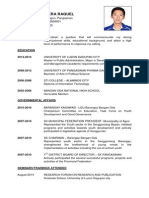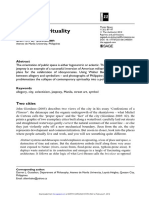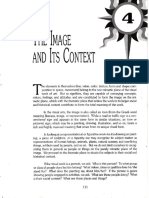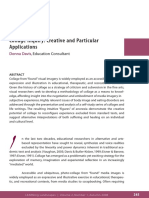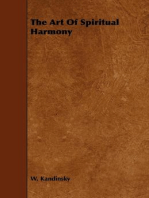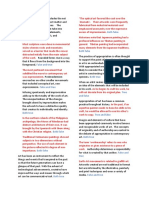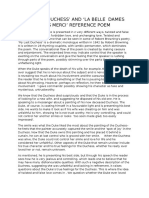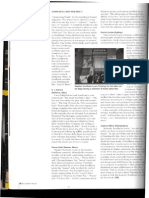Professional Documents
Culture Documents
The Cover
The Cover
Uploaded by
Richard RaquelOriginal Title
Copyright
Available Formats
Share this document
Did you find this document useful?
Is this content inappropriate?
Report this DocumentCopyright:
Available Formats
The Cover
The Cover
Uploaded by
Richard RaquelCopyright:
Available Formats
The Cover
Postmodernism eschews grand narratives; postmodern art,
represented here by the work of Eric Adalla Carbon (originally
representing Bangan Oda National High School, now an
education major at the Pangasinan State University-Lingyen;
28.5” x 22.5”, pastel on cartolina, winner of Panagdayao Festival
2018 art contest), turns to collision, collage and fragmentation in
subverting conventions. One could also read pluralism and
diversity in postmodern works and Carbon’s winning entry is an
elegant pastiche which draws heavily from the figurative art
movement led by the likes of today’s contemporary standouts in
the artistic firmament: Elmer Borlongan, Ivan Roxas and Patrick
Flores. It appears that, whether consciously or subconsciously,
Carbon parlays his instincts to the hilt, and the deployment of his
art is partly tempered and driven by the seeming influences of this
movement.
Figurative art is representational (Whang, 2015) and Carbon
dives deep deftly into his rustic milieu and experiences; even
taming an activist ideology, as if half-thinking about a pleasant
memory.
One stark look into Carbon’s work of art will not reveal the
hidden meanings. That’s the beauty of figurative art – the irony is
both muted and mysterious; visceral and vicarious. The
disoriented, disfigured or altered figures and anatomy foreground
the material. It takes volumes of semiotic reading and a constant
negotiation to see the pristine, distilled message. By and large, however, the work embodies a watermark of conflated
artistry and intellect built on faith.
While Carbon plays to the trope and conventions of figurative art, there are three things which make his work entirely
his own. The artist reimagines the role of the church in postmodern times, certainly not as an ideological apparatus but a
breathing and living institution that draws its vitality from the youth. His work argues: it is in the context of celebration of
the faith that spiritual power becomes all-encompassing. The central message is palpable and clear: the mind and heart
work together—especially of the youth—for a purposive mission. The Church is, despite the multiplicity of voices, is alive –
Carbon’s work declares, as represented by the central image of a spiritually engaged and faith-enabled youth iconography.
At its core, Carbon’s work speaks to the people in theological terms as it succinctly articulates Pope Francis’ Post-
Synodal Apostolic Exhortation entitled Christus Vivit. The Holy Father opens it, thus:
“Christ is alive! He is our hope, and in a wonderful way he brings youth to our world, and everything he touches
becomes young, new, full of life. The very first words, then, that I would like to say to very young Christian are these:
Christ is alive and he wants you to be alive!”
The art work also speaks of the youth as deep reservoir of empathy, compassion and love and captures these in line
with the following stirring words: In a word, true youth means having a heart capable of loving, whereas everything that
separates us from others makes the soul grow old. (Pope Francis, 2019)
And finally, Carbon’s vision manifests itself and intersects so beautifully and majestically with the following text from
the Post-Synodal document:
[Jesus’] youth teaches us. Jesus does not teach you, young people, from afar or from without, but from within your
very youth, a youth he shares with you. It is very important for you to contemplate the young Jesus s presented in the
Gospels, for he was truly one of you, and shares many of the features of your young hearts. We see this for example in the
following: “Jesus had unconditional trust in the Father; he maintained friendships with his disciples, and even in
moments of crisis, he remained faithful to them. He showed profound compassion for the weakest, especially the poor, the
sick, sinners and the excluded. He had the courage to confront the religious and political authorities of his time; he knew
what it was to feel misunderstood and rejected; he experienced the fear of suffering and he knew the frailty of the Passion.
He turned his gaze to the future, entrusting himself into the Father’s safe hands in the strength of the Spirit. In Jesus, all
the young can see themselves.
Clearly, the theological underpinnings of Carbon’s art lend truth to this aphorism: a painting is complete when it has
the shadows of God. (Nemo, 1975)
To make the critique complete, it is necessary to train our sights on the artistic direction of the techie artist Marvic
Justin Garcia Napata. In this digital rendering, the sense of balance is instructive and his choice of typography stands out
as his greatest suit—it plays, in indirect proportions, to the strength of the main image. Garcia’s aesthetics leans towards
sophistication that is derived from simplicity and minimalism.
In sum, the overall vibe of the visual copy leaps off the cover page. Without doubt, Carbon’s artistry fits the leitmotif of
the Panagdayao Festival: seminal and subtle yet spiritual and soulful. The least one could say is that it is not a carbon
copy, but is, in fact, Carbon’s copy.
_________________________________
Art critique essay by Jerry Benedict Cabantac Rosete. The author is a documentarist-filmmaker-film critique (MA candidate, MA in Media Studies-
Film, UP Film Institute, UP Diliman), writer, multimedia practitioner and lecturer on gender and cultural studies, thesis consultant and adviser on
economics, business and film. Mr. Rosete is the first and only Agnoan to have landed an editorial post in a nationally-circulated publication (ABSCBN
Publishing, Inc.). At present, he works as an information officer at the Office of the Ombudsman-Media Bureau. He is also designated as the Executive
Chairperson of the forthcoming Agno Town Fiesta 2020.
You might also like
- 10 Fundamental Questions of CuratingDocument145 pages10 Fundamental Questions of Curatingjan100% (11)
- Barangay Ordinance Astray AnimalsDocument8 pagesBarangay Ordinance Astray AnimalsRichard Raquel100% (18)
- MODULE 1 - Assumptions and Nature of Arts - Creativity and ImaginationDocument26 pagesMODULE 1 - Assumptions and Nature of Arts - Creativity and ImaginationJomari Falible67% (3)
- Flooding PrayerDocument1 pageFlooding PrayerRichard RaquelNoch keine Bewertungen
- Resume ChadDocument3 pagesResume ChadRichard Raquel100% (1)
- GoccDocument40 pagesGoccRichard Raquel50% (2)
- Logo Design GuideDocument16 pagesLogo Design GuideSyed Andrabi100% (5)
- Grafton - Dover - Arms and Armor R PDFDocument127 pagesGrafton - Dover - Arms and Armor R PDFGabriela Ferreira Marques80% (5)
- Module 7 ARt Appreciation DoneDocument19 pagesModule 7 ARt Appreciation DoneJohn Henry TampoyNoch keine Bewertungen
- Jean Paul Nazar Foundation BookDocument74 pagesJean Paul Nazar Foundation BookAmaan KhanNoch keine Bewertungen
- CAEIRO-EN-Korbicka-1 EDITS DONEDocument14 pagesCAEIRO-EN-Korbicka-1 EDITS DONEMário CaeiroNoch keine Bewertungen
- Two Girls ReadingDocument17 pagesTwo Girls Readingheinhtetaung412003Noch keine Bewertungen
- Module 1 Lesson 3Document7 pagesModule 1 Lesson 3nrngl143Noch keine Bewertungen
- Reviewer in CparDocument3 pagesReviewer in CparMariela MendozaNoch keine Bewertungen
- Hieromonk+Silouan+ +in+Search+for+the+Sacred+ImageDocument33 pagesHieromonk+Silouan+ +in+Search+for+the+Sacred+ImageFarashaNoch keine Bewertungen
- Radu ŞerbanDocument8 pagesRadu ŞerbanszerencsesarkanyNoch keine Bewertungen
- Group 2 PPT 39 50Document28 pagesGroup 2 PPT 39 50KNARF FRANKNoch keine Bewertungen
- Name of Artist Background Profile Artwork Contribution Medium Techniques Fernando Cueto AmorsoloDocument24 pagesName of Artist Background Profile Artwork Contribution Medium Techniques Fernando Cueto AmorsoloClarisse MendozaNoch keine Bewertungen
- CPAR-REVIEWER (1) BBDocument3 pagesCPAR-REVIEWER (1) BBcacaoloidelmarbatinobestNoch keine Bewertungen
- Lesson 4 Visual Arts Painting Drawing PhotographyDocument4 pagesLesson 4 Visual Arts Painting Drawing Photographysydney.socoNoch keine Bewertungen
- The Bifa Concept in Jing Hao S Bifaji PaDocument10 pagesThe Bifa Concept in Jing Hao S Bifaji PaJasmineNoch keine Bewertungen
- Mountain and Water Painting As A TaleDocument7 pagesMountain and Water Painting As A TaleBoalio ForsiNoch keine Bewertungen
- SodaPDF Merged Merging ResultDocument87 pagesSodaPDF Merged Merging ResultMa.Terrisa Paula DeanonNoch keine Bewertungen
- Darren Gustafson-Jeepney SpiritualityDocument11 pagesDarren Gustafson-Jeepney SpiritualityDarryl Myr FloranoNoch keine Bewertungen
- Nature Functions Values and Coordinates of Art With Subject Types and ContentDocument60 pagesNature Functions Values and Coordinates of Art With Subject Types and ContentCelne CentinoNoch keine Bewertungen
- Cpar 1ST Sem (Finals)Document4 pagesCpar 1ST Sem (Finals)Misaki AyazawaNoch keine Bewertungen
- Lesson 3Document11 pagesLesson 3Mark Angelo RamosNoch keine Bewertungen
- Stefan Arteni: The Way of Form - A RetrospectiveDocument85 pagesStefan Arteni: The Way of Form - A Retrospectivestefan arteniNoch keine Bewertungen
- Integrative ArtsDocument2 pagesIntegrative ArtsangelanatifayNoch keine Bewertungen
- Lecture 4 Art Criticism Group 1Document5 pagesLecture 4 Art Criticism Group 1Jelbern BacongNoch keine Bewertungen
- Cpar Module 1 1Document53 pagesCpar Module 1 1Sen paiNoch keine Bewertungen
- Visual AnalysisDocument2 pagesVisual AnalysisDADOR, Allyson Mari T.Noch keine Bewertungen
- Week 1 Gec 106Document16 pagesWeek 1 Gec 106Junjie FuentesNoch keine Bewertungen
- Art Appreciation Group 1Document19 pagesArt Appreciation Group 1Juvy Anne DiñaNoch keine Bewertungen
- Subject and Content of ArtDocument22 pagesSubject and Content of ArtAngilly LibreaNoch keine Bewertungen
- Body WebsDocument118 pagesBody WebsuilltexcanallNoch keine Bewertungen
- ImagecontextDocument16 pagesImagecontextCee MinNoch keine Bewertungen
- Subject & Content: Ms. Bianca NuestroDocument20 pagesSubject & Content: Ms. Bianca NuestroChristian ArellanoNoch keine Bewertungen
- Bodily Representations in The BaroqueDocument11 pagesBodily Representations in The Baroquedalila544Noch keine Bewertungen
- 287-Article Text-56-1-10-20170226 PDFDocument21 pages287-Article Text-56-1-10-20170226 PDFLina Kahloune SolerNoch keine Bewertungen
- Contempo Reviewer (1 Periodical) Module 1 Lesson 1: What Is Art?Document17 pagesContempo Reviewer (1 Periodical) Module 1 Lesson 1: What Is Art?Fitri CeradoNoch keine Bewertungen
- Rhythm: GE 216/213 (Arts Apps and Humanities)Document3 pagesRhythm: GE 216/213 (Arts Apps and Humanities)jeryl generalaoNoch keine Bewertungen
- Block 9 PDFDocument76 pagesBlock 9 PDFShahid AarfiNoch keine Bewertungen
- Module 1 Lesson 4Document6 pagesModule 1 Lesson 4Maisa VillafuerteNoch keine Bewertungen
- Cpar ReviewerDocument12 pagesCpar Reviewerfranzkafka978Noch keine Bewertungen
- Contemporary Phil Arts Quarter 1.Document9 pagesContemporary Phil Arts Quarter 1.Anne Chelsea De LaraNoch keine Bewertungen
- Cpar ReviewerDocument36 pagesCpar ReviewerPrisca Aquila JaspeNoch keine Bewertungen
- Gen EdDocument27 pagesGen EdChristian TaladtadNoch keine Bewertungen
- ROSENBLUM, R. On de Kooning Late Style RosenblumDocument3 pagesROSENBLUM, R. On de Kooning Late Style RosenblumNicolas AmaralNoch keine Bewertungen
- Contemporary Philippine Arts From The RegionsDocument9 pagesContemporary Philippine Arts From The RegionsAngela AgbalogNoch keine Bewertungen
- Abstract Expressionism Research PaperDocument5 pagesAbstract Expressionism Research Paperfvf442bf100% (1)
- Contemporary Philippine Arts From The RegionDocument5 pagesContemporary Philippine Arts From The Regionjohnahronramos30Noch keine Bewertungen
- Art Appreciation Module 2Document10 pagesArt Appreciation Module 2Maden betoNoch keine Bewertungen
- Archetype and SymbolDocument11 pagesArchetype and SymbolAnonymous Y2qwEuANoch keine Bewertungen
- Cpar ReviewerDocument3 pagesCpar ReviewerMichelyn MacantanNoch keine Bewertungen
- Cpar 2 Pre - AssessmentDocument3 pagesCpar 2 Pre - AssessmentUnkinked Bacon21Noch keine Bewertungen
- Chap 1 HandoutsDocument9 pagesChap 1 HandoutsnenyaneriNoch keine Bewertungen
- Contemporary Modern Arts CPARDocument6 pagesContemporary Modern Arts CPARPat SubereNoch keine Bewertungen
- Gardner PalmerDocument2 pagesGardner PalmerfistfullofmetalNoch keine Bewertungen
- Arta Final ExamDocument5 pagesArta Final Examxuxi dulNoch keine Bewertungen
- Lao Lianben - SubstanceDocument36 pagesLao Lianben - SubstanceBao-Wei SuNoch keine Bewertungen
- (The Greeks) Called It KOSMOS, Which MeansDocument11 pages(The Greeks) Called It KOSMOS, Which Meanscristian.fl.berger100% (1)
- 12 CparDocument17 pages12 CparKiel LegaspiNoch keine Bewertungen
- Week2 LessonDocument29 pagesWeek2 LessonRUZEL RIGORNoch keine Bewertungen
- Reviewer CPAR Grade 12 Stem First SemesterDocument5 pagesReviewer CPAR Grade 12 Stem First SemesterhendazayaciaNoch keine Bewertungen
- Affidavit of Loss: Richard Noguera RaquelDocument1 pageAffidavit of Loss: Richard Noguera RaquelRichard RaquelNoch keine Bewertungen
- Ethics ValuesDocument11 pagesEthics ValuesRichard RaquelNoch keine Bewertungen
- Thank You Ma'am For That IntroductionDocument7 pagesThank You Ma'am For That IntroductionRichard RaquelNoch keine Bewertungen
- Museum Graphics DesignDocument7 pagesMuseum Graphics DesignJerzy Mae GloriosoNoch keine Bewertungen
- Prepositions of Places: 1) at - in - OnDocument4 pagesPrepositions of Places: 1) at - in - OnMoz SegundoNoch keine Bewertungen
- POP-ROCK Repertoar NovoDocument9 pagesPOP-ROCK Repertoar Novojelena bozovicNoch keine Bewertungen
- Japan-Ness in ArchitectureDocument4 pagesJapan-Ness in ArchitectureOlivia IendahhNoch keine Bewertungen
- Earth Unit - Grade 1Document93 pagesEarth Unit - Grade 1Morgan BaydaNoch keine Bewertungen
- Lab Dip Submittal FormDocument1 pageLab Dip Submittal FormHaseeb AnwarNoch keine Bewertungen
- Geechee One Magazine - December 2013Document40 pagesGeechee One Magazine - December 2013F. Khristopher BlueNoch keine Bewertungen
- Wong Douglas - The Deceptive Hands of Wing ChunDocument63 pagesWong Douglas - The Deceptive Hands of Wing ChunHector Lopez50% (2)
- Knitting (Hat Pattern)Document2 pagesKnitting (Hat Pattern)vorliebye64Noch keine Bewertungen
- DJ MAG Top 100 DJs Poll Results 1997Document6 pagesDJ MAG Top 100 DJs Poll Results 1997Marcus GutiérrezNoch keine Bewertungen
- 2015.282320.the Ratnavali TextDocument312 pages2015.282320.the Ratnavali TextSubramanian NavaneethakrishnanNoch keine Bewertungen
- Stephen Sondheim and His Filmic InfluencesDocument89 pagesStephen Sondheim and His Filmic InfluencesJamesRuth67% (3)
- Sailor: Respect Is Earned, Honesty Is Appreciated, Love Is Gained and Loyalty Is ReturnedDocument12 pagesSailor: Respect Is Earned, Honesty Is Appreciated, Love Is Gained and Loyalty Is ReturnedNilda Isabel Tolaba Arce100% (3)
- Digital Booklet - Reminiscences of RussiaDocument4 pagesDigital Booklet - Reminiscences of RussiaHoàng Ngọc-Tuấn100% (1)
- MY LAST DUCHESS La Belee Refercne PoemDocument2 pagesMY LAST DUCHESS La Belee Refercne PoemHadi AlnaherNoch keine Bewertungen
- Summative MusicDocument2 pagesSummative MusicBernivie TenajaNoch keine Bewertungen
- APA FormatDocument27 pagesAPA FormatTrần Quang VinhNoch keine Bewertungen
- Expository Texts FeaturesDocument11 pagesExpository Texts Featuresdaviid.filosofoNoch keine Bewertungen
- Van Halen Bootlegs ListDocument14 pagesVan Halen Bootlegs ListPeter Justin HaightNoch keine Bewertungen
- Airbrush Technique Magazine Issue48Document32 pagesAirbrush Technique Magazine Issue48Roberto SavoiaNoch keine Bewertungen
- Gregorian Press ReleaseDocument6 pagesGregorian Press Releaseapi-327146591Noch keine Bewertungen
- Attaching Hook and EyeDocument26 pagesAttaching Hook and EyeJanica A. MalunayNoch keine Bewertungen
- Finishing The Hat ReviewDocument1 pageFinishing The Hat ReviewAndrew MilnerNoch keine Bewertungen
- Generation Artist 2Document79 pagesGeneration Artist 2TartanmonkeyNoch keine Bewertungen
- Making Colour Ulrike Kern 102014Document2 pagesMaking Colour Ulrike Kern 102014ValdrianaCorrêaNoch keine Bewertungen
- "Out of Order!" or Are They? A Textual and Visual Analysis of Two Dedicatory Texts On Classic Maya Ceramics - by Erik BootDocument23 pages"Out of Order!" or Are They? A Textual and Visual Analysis of Two Dedicatory Texts On Classic Maya Ceramics - by Erik BootedojidaiNoch keine Bewertungen
- Lesson29 The Missing GloveDocument14 pagesLesson29 The Missing Glove브곰잉Noch keine Bewertungen




